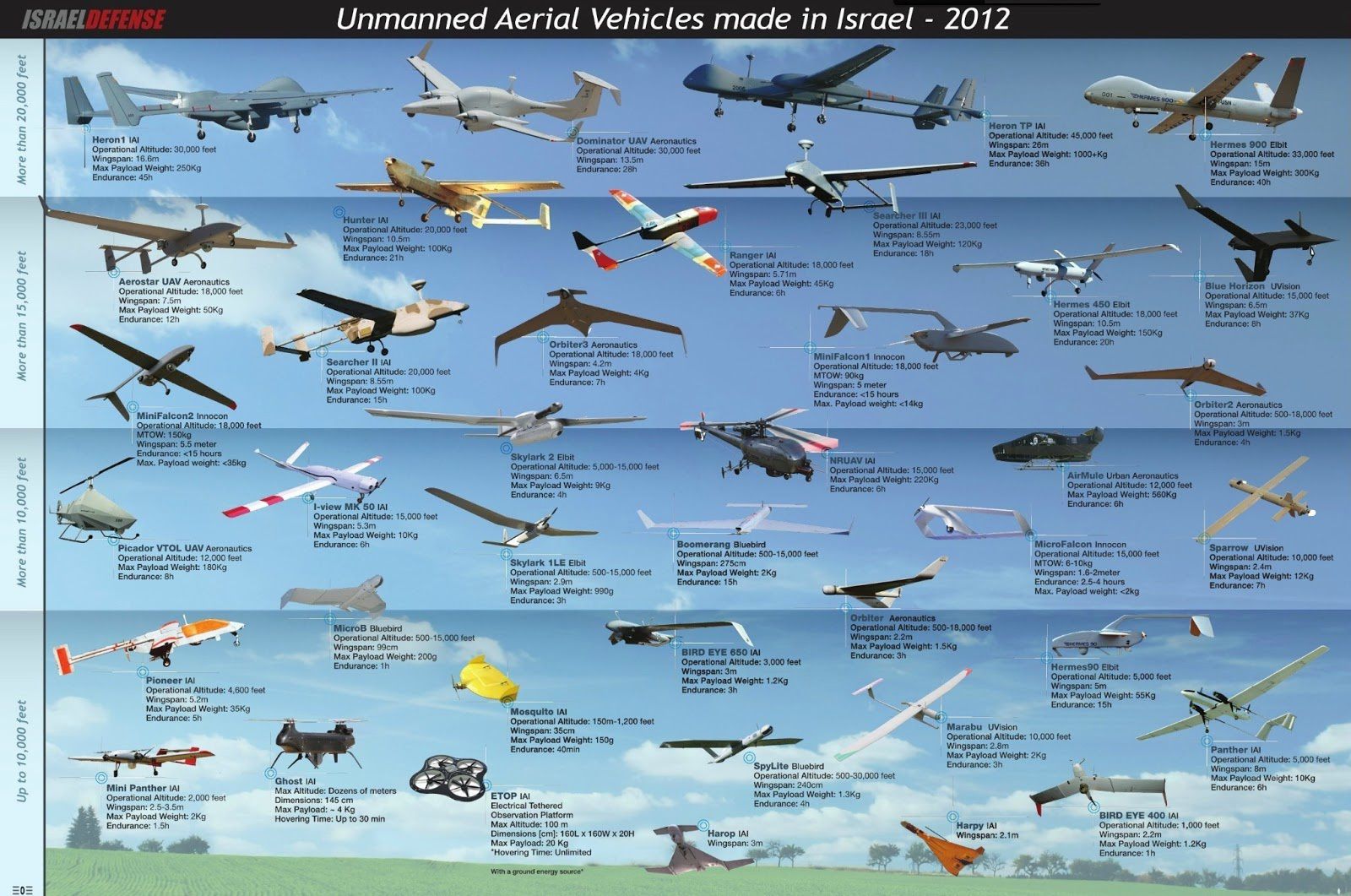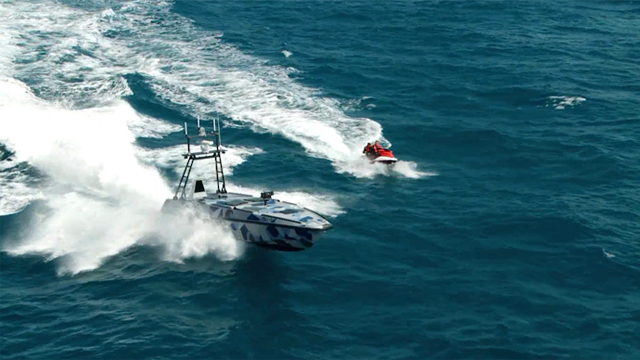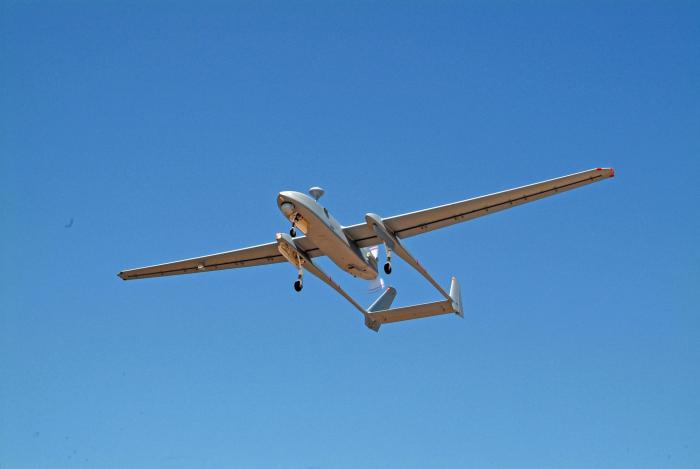DavidSling
SENIOR MEMBER

- Joined
- Oct 25, 2013
- Messages
- 4,826
- Reaction score
- 0
- Country
- Location
Israel is considered the largest exporter of drones. Between 2010 and 2014, it delivered 165 units across the globe. The US came second with 132, followed by Italy’s 37.
Since 1985, Israel has accounted for the majority (60.7%) of drone exports worldwide. Despite China’s move into armed UAV exports, it only supplied 0.9% of total exports during this last couple of decades.
According to many foreign forces, Israeli drones are armed with hellfire and spike missiles, altho the Israeli goverment didn't admit nor denied possesing such capabilities
So what drones does Israel has ?
Main ones are :
IAI Heron TP (Eitan) - an advanced, multi-purpose MALE UAS with an extended performance envelope and a variety of payloads capability.
The Heron TP was designed as a multi-purpose, multi-system platform to address local and international customers' needs and to perform a variety of strategic missions with a high level of reliability.
The HERON TP main features and capabilities are:
Multi mission platform with multiple operational configurations
Large internal volume for a variety of payloads
Simultaneous and flexible operation of payloads
All weather capability
Operation above commercial traffic
Satellite communication for extended range (SATCOM)
Automatic Takeoff and Landing (ATOL) systems for maximal safety
Triple, fully redundant, state-of-the-art avionics
Retractable landing gear
Safe, reliable and easy operation
Payloads
EO/IR/LRF
SAR
MPR
ELINT
COMINT
ESM
Data Links
Line of Sight
Satellite communication (SATCOM)
Performance
Endurance: 36 hr
Range: Beyond Line of Sight (BLOS) with SATCOM
Altitude: 45,000 ft
Weights
Max take-off weight: 4,650 kg
Typical mission payload: 1,000 kg
Dimensions
Overall length 14 m
Wingspan 26 m
Engine: 1,200 hp Turbo Prop

IAI Heron (known as shoval or machatz 1) - a Medium Altitude Long Endurance (MALE) UAS for strategic and tactical missions
The HERON main features and capabilities are:
Safe, reliable and easy operation
Simultaneously 6 sensors use capability
Satellite communication for extended range (SATCOM)
Two proven simultaneous Automatic Takeoff and Landing (ATOL) systems for maximal safety
Fully redundant, state-of-the-art avionics
Retractable landing gear
Payloads
Electro Optical (TV & IR Combi or Triple Sensor TV/IR/LD)
Synthetic Aperture Radar (SAR)
Maritime Patrol Radar (MPR)
COMINT & ESM capability
Customer furnished sensor suites
Communication relay package
Integrated ATC Radio
Datalinks
Direct Line-of-Sight (LOS) data link
UAV airborne data relay (ADR) for beyond LOS missions
Ground-based data relay (GDR) for beyond LOS missions
Satellite communication
Performance
Endurance: > 40 hr
Range: 350 km
Range with satellite coverage: Beyond Line of Sight
Altitude: 30,000 ft
Technical Data
Weights
Maximum take-off weight: 1,250 kg
Maximum Payload Weight: 250 Kg
Dimensions
Overall Length: 8.50 m
Wingspan: 16.60 m

Elbit Hermes 900(kochav) - Sharp senses, lethal bite Elbit System’s Hermes® 900 UAS is equipped with a variety of high performance sensors, allowing it to detect ground or maritime .targets, over a wide spectral range Hermes® 900 provides over the horizon, persistent multi-payload .capabilities It is based on the proven and mature building blocks of Elbit System’s Hermes® family setting the highest levels of .airworthiness, safety & reliability Latest MALE UAS procured by the IDF & by multiple international user.
Major Features
Highly autonomous & mission effective
Multiple hard points & 250 Kg modular installation bay
Satellite Communication & LOS Data Link
Adverse weather capabilities
Designed for minimal maintenance
Wide variety of cutting edge payloads :
EO/IR/Laser Designator, Long Range EO/IR
SAR/GMTI & MPR + AIS
ELINT, EW, COMINT, COMJAM
Wide Area Surveillance / Mapping
Hyper Spectral
Communication Relay
Other
Take-off weight 1,180 kg
Max Payload 350 kg
Endurance up to 36 hours
Service Ceiling 30,000 ft

Elbit Hermes 450 - A multi-role high performance tactical UAS and the primary platform of the IDF in counter-terror operations, Hermes 450 is a mature and combat proven UAS with over 300,000 operational flight hours and a class leading safety and reliability record.
Hermes 450 incorporates cutting edge payloads with selected dual-payload configurations. Choice of payloads includes EO/IR/Laser, SAR/GMTI & MPR, COMINT/COMMJAM, ELINT, hyper-spectral systems, large area scanning systems and other payloads. Hermes 450’s highly autonomous and ergonomic operation results in high mission effectiveness with no piloting skills required.
The system is easily mobilized and rapidly deployable. Mission management is performed via the HermesGCS. Hermes 450 can perform two concurrent missions from the same GCS using two2 GDTs.
As you read these lines, there are bound to be over 20 At any given time numerous Hermes UAVs UAS are airborne performing for operational missions worldwide. Hermes 450 is the basis for the UK WATCHKEEPER program.
Performance:
Take-off weight 550 kg
Max Payload 180 kg
Endurance 17 hours
Service Ceiling 18,000 ft
Range 300 km

IAI Harpy - is an unmanned combat aerial vehicle (UCAV) produced by Israel Aerospace Industries. The Harpy is designed to attack radar systems and is optimised for the SEAD role. It carries a high explosivewarhead. The Harpy has been sold to several foreign nations, including South Korea, Turkey, India, and China.
General characteristics
Length: 2.7 m (8 ft 10 in)
Wingspan: 2.1 m (6 ft 11 in)
Powerplant: 1 × UEL AR731 Wankel rotary engine, 28 kW (38 hp)
Performance
Maximum speed: 185 km/h (115 mph; 100 kn)
Range: 500 km (311 mi; 270 nmi)
Armament
1 × 32 kg (70 lb) high-explosive warhead

The IAI Harop (or IAI Harpy 2) - an unmanned combat air vehicle (UCAV) developed by the MBT division of Israel Aerospace Industries. Rather than holding a separate high-explosivewarhead, the drone itself is the main munition. This SEAD-optimised UCAV is designed to loiter the battlefield and attack targets by self-destructing into them.
General characteristics
Crew: None
Length: 2.5 m (8 ft 2 in)
Wingspan: 3.00 m (9 ft 10 in)
Performance
Range: 1000 km ( miles)
Endurance: 6 hours 0 min
Armament
23 kg (51 lb) warhead

Skylark - The Elbit Systems Skylark I and Skylark II are small Miniature UAVs developed by Elbit Systems.
Skylark I
The Skylark I is a Miniature UAV. It is designed as a manpacked system for tactical surveillance and reconnaissance. The Skylark is launched by hand. The payload consists of a daylight CCD or optional FLIR for night operations. During operation, it sends real-time video to a portable ground station. Recovery involves a deep stall maneuver, landing on a small inflatable cushion. It has a range of 20/40 km.
The Skylark is in operation with the militaries of Australia, Canada, Croatia, Czech Republic, Hungary, Israel, Macedonia, Netherlands, Poland, Slovakia and Sweden. It has been deployed in Afghanistan and Iraq.The Skylark I has also been selected by France's Special Forces in March 2008.In total, it has been selected by more than 20 operators worlwide.
Skylark II
The Skylark II was unveiled in 2006. It has a range of 60 km and is designed to be operated by a two-person crew and to be deployed using HMMWV class field vehicles. In December 2007, South Korea decided to purchase the Skylark II system. Israel planned to bring the Skylark II into service by mid-2013.

Super Heron (yet to get into the IDF) - the new and latest Medium Altitude Long Endurance Unmanned Aircraft System (MALE UAS) made by IAI/Malat. The Super Heron was added as a link between the Heron and the Heron TP UAV systems.
The main features of the Super Heron are the following:
A new advance propulsion system specifically developed for the Super Heron with a 200 Hp heavy fuel (diesel) engine and fuel injection compared to the 100 Hp gasoline engine of the Heron UAV.
Fuselage and wings changes:
Provision for large and heavy payloads
Provision for a large SATCOM antenna.
5% lower drag for flight efficiency
Subsystems upgrade:
Advanced avionics, triple redundancy and advanced computerized systems
Advanced communication system including SATCOM for BLOS communication
Multiple hard points for various payloads (fuel tanks, Sigint, radar and more).
Improved performance
Increased maximum speed
Increased rate of climb
Payload weight - up to 450 kg.
Latest technology and Advanced production methods result in:
Growth potential (volume, processing capability, electrical power)
Reduced weight
Improved repeatability
Multiple operational configurations for intelligence, maritime patrol, persistent surveillance
Multi sensor capability - up to six simultaneously
Proven safe, dual automatic takeoff and landing system (ATOL).
Retractable landing gear
Payloads - up to six operating simultaneously
EO/IR/LRF/Laser designator
SAR/MPR
Hyper spectral
ELINT
COMINT
COM Relay
Comjam
Comint GSM
Scanner
Mapping
Customer furnished sensor suits
Communication Relay package
Data links
Advance direct line of sight (LOS) data kink
Advanced Satellite Communication (SATCOM) for BLOS missions
UAV airborne data relay (ADR) for BLOS missions
Ground based data relay (GDR) for BLOS missions
Performance
Endurance: Up to 45 hours
Mission radius LOS: 250 km
Mission radius with ADR or GDR: 350 km
Mission radius with SATCOM: > 1,000 km
Altitude ceiling: > 30,000 ft
Loiter speed: 60-80 kTAS
Max speed: >150 kTAS
Technical Data
Weights
Maximum takeoff weight (MTOW): 1,450 kg
Payload weight: Up to 450 kg.
Dimensions
Wingspan: 17 m

Altho many more drones are manufacture and produce by the Israeli industries

Sources : Israeli Aerospace Industries website, Elbit website,Wikipedia
Since 1985, Israel has accounted for the majority (60.7%) of drone exports worldwide. Despite China’s move into armed UAV exports, it only supplied 0.9% of total exports during this last couple of decades.
According to many foreign forces, Israeli drones are armed with hellfire and spike missiles, altho the Israeli goverment didn't admit nor denied possesing such capabilities
So what drones does Israel has ?
Main ones are :
IAI Heron TP (Eitan) - an advanced, multi-purpose MALE UAS with an extended performance envelope and a variety of payloads capability.
The Heron TP was designed as a multi-purpose, multi-system platform to address local and international customers' needs and to perform a variety of strategic missions with a high level of reliability.
The HERON TP main features and capabilities are:
Multi mission platform with multiple operational configurations
Large internal volume for a variety of payloads
Simultaneous and flexible operation of payloads
All weather capability
Operation above commercial traffic
Satellite communication for extended range (SATCOM)
Automatic Takeoff and Landing (ATOL) systems for maximal safety
Triple, fully redundant, state-of-the-art avionics
Retractable landing gear
Safe, reliable and easy operation
Payloads
EO/IR/LRF
SAR
MPR
ELINT
COMINT
ESM
Data Links
Line of Sight
Satellite communication (SATCOM)
Performance
Endurance: 36 hr
Range: Beyond Line of Sight (BLOS) with SATCOM
Altitude: 45,000 ft
Weights
Max take-off weight: 4,650 kg
Typical mission payload: 1,000 kg
Dimensions
Overall length 14 m
Wingspan 26 m
Engine: 1,200 hp Turbo Prop

IAI Heron (known as shoval or machatz 1) - a Medium Altitude Long Endurance (MALE) UAS for strategic and tactical missions
The HERON main features and capabilities are:
Safe, reliable and easy operation
Simultaneously 6 sensors use capability
Satellite communication for extended range (SATCOM)
Two proven simultaneous Automatic Takeoff and Landing (ATOL) systems for maximal safety
Fully redundant, state-of-the-art avionics
Retractable landing gear
Payloads
Electro Optical (TV & IR Combi or Triple Sensor TV/IR/LD)
Synthetic Aperture Radar (SAR)
Maritime Patrol Radar (MPR)
COMINT & ESM capability
Customer furnished sensor suites
Communication relay package
Integrated ATC Radio
Datalinks
Direct Line-of-Sight (LOS) data link
UAV airborne data relay (ADR) for beyond LOS missions
Ground-based data relay (GDR) for beyond LOS missions
Satellite communication
Performance
Endurance: > 40 hr
Range: 350 km
Range with satellite coverage: Beyond Line of Sight
Altitude: 30,000 ft
Technical Data
Weights
Maximum take-off weight: 1,250 kg
Maximum Payload Weight: 250 Kg
Dimensions
Overall Length: 8.50 m
Wingspan: 16.60 m

Elbit Hermes 900(kochav) - Sharp senses, lethal bite Elbit System’s Hermes® 900 UAS is equipped with a variety of high performance sensors, allowing it to detect ground or maritime .targets, over a wide spectral range Hermes® 900 provides over the horizon, persistent multi-payload .capabilities It is based on the proven and mature building blocks of Elbit System’s Hermes® family setting the highest levels of .airworthiness, safety & reliability Latest MALE UAS procured by the IDF & by multiple international user.
Major Features
Highly autonomous & mission effective
Multiple hard points & 250 Kg modular installation bay
Satellite Communication & LOS Data Link
Adverse weather capabilities
Designed for minimal maintenance
Wide variety of cutting edge payloads :
EO/IR/Laser Designator, Long Range EO/IR
SAR/GMTI & MPR + AIS
ELINT, EW, COMINT, COMJAM
Wide Area Surveillance / Mapping
Hyper Spectral
Communication Relay
Other
Take-off weight 1,180 kg
Max Payload 350 kg
Endurance up to 36 hours
Service Ceiling 30,000 ft

Elbit Hermes 450 - A multi-role high performance tactical UAS and the primary platform of the IDF in counter-terror operations, Hermes 450 is a mature and combat proven UAS with over 300,000 operational flight hours and a class leading safety and reliability record.
Hermes 450 incorporates cutting edge payloads with selected dual-payload configurations. Choice of payloads includes EO/IR/Laser, SAR/GMTI & MPR, COMINT/COMMJAM, ELINT, hyper-spectral systems, large area scanning systems and other payloads. Hermes 450’s highly autonomous and ergonomic operation results in high mission effectiveness with no piloting skills required.
The system is easily mobilized and rapidly deployable. Mission management is performed via the HermesGCS. Hermes 450 can perform two concurrent missions from the same GCS using two2 GDTs.
As you read these lines, there are bound to be over 20 At any given time numerous Hermes UAVs UAS are airborne performing for operational missions worldwide. Hermes 450 is the basis for the UK WATCHKEEPER program.
Performance:
Take-off weight 550 kg
Max Payload 180 kg
Endurance 17 hours
Service Ceiling 18,000 ft
Range 300 km

IAI Harpy - is an unmanned combat aerial vehicle (UCAV) produced by Israel Aerospace Industries. The Harpy is designed to attack radar systems and is optimised for the SEAD role. It carries a high explosivewarhead. The Harpy has been sold to several foreign nations, including South Korea, Turkey, India, and China.
General characteristics
Length: 2.7 m (8 ft 10 in)
Wingspan: 2.1 m (6 ft 11 in)
Powerplant: 1 × UEL AR731 Wankel rotary engine, 28 kW (38 hp)
Performance
Maximum speed: 185 km/h (115 mph; 100 kn)
Range: 500 km (311 mi; 270 nmi)
Armament
1 × 32 kg (70 lb) high-explosive warhead

The IAI Harop (or IAI Harpy 2) - an unmanned combat air vehicle (UCAV) developed by the MBT division of Israel Aerospace Industries. Rather than holding a separate high-explosivewarhead, the drone itself is the main munition. This SEAD-optimised UCAV is designed to loiter the battlefield and attack targets by self-destructing into them.
General characteristics
Crew: None
Length: 2.5 m (8 ft 2 in)
Wingspan: 3.00 m (9 ft 10 in)
Performance
Range: 1000 km ( miles)
Endurance: 6 hours 0 min
Armament
23 kg (51 lb) warhead

Skylark - The Elbit Systems Skylark I and Skylark II are small Miniature UAVs developed by Elbit Systems.
Skylark I
The Skylark I is a Miniature UAV. It is designed as a manpacked system for tactical surveillance and reconnaissance. The Skylark is launched by hand. The payload consists of a daylight CCD or optional FLIR for night operations. During operation, it sends real-time video to a portable ground station. Recovery involves a deep stall maneuver, landing on a small inflatable cushion. It has a range of 20/40 km.
The Skylark is in operation with the militaries of Australia, Canada, Croatia, Czech Republic, Hungary, Israel, Macedonia, Netherlands, Poland, Slovakia and Sweden. It has been deployed in Afghanistan and Iraq.The Skylark I has also been selected by France's Special Forces in March 2008.In total, it has been selected by more than 20 operators worlwide.
Skylark II
The Skylark II was unveiled in 2006. It has a range of 60 km and is designed to be operated by a two-person crew and to be deployed using HMMWV class field vehicles. In December 2007, South Korea decided to purchase the Skylark II system. Israel planned to bring the Skylark II into service by mid-2013.
Super Heron (yet to get into the IDF) - the new and latest Medium Altitude Long Endurance Unmanned Aircraft System (MALE UAS) made by IAI/Malat. The Super Heron was added as a link between the Heron and the Heron TP UAV systems.
The main features of the Super Heron are the following:
A new advance propulsion system specifically developed for the Super Heron with a 200 Hp heavy fuel (diesel) engine and fuel injection compared to the 100 Hp gasoline engine of the Heron UAV.
Fuselage and wings changes:
Provision for large and heavy payloads
Provision for a large SATCOM antenna.
5% lower drag for flight efficiency
Subsystems upgrade:
Advanced avionics, triple redundancy and advanced computerized systems
Advanced communication system including SATCOM for BLOS communication
Multiple hard points for various payloads (fuel tanks, Sigint, radar and more).
Improved performance
Increased maximum speed
Increased rate of climb
Payload weight - up to 450 kg.
Latest technology and Advanced production methods result in:
Growth potential (volume, processing capability, electrical power)
Reduced weight
Improved repeatability
Multiple operational configurations for intelligence, maritime patrol, persistent surveillance
Multi sensor capability - up to six simultaneously
Proven safe, dual automatic takeoff and landing system (ATOL).
Retractable landing gear
Payloads - up to six operating simultaneously
EO/IR/LRF/Laser designator
SAR/MPR
Hyper spectral
ELINT
COMINT
COM Relay
Comjam
Comint GSM
Scanner
Mapping
Customer furnished sensor suits
Communication Relay package
Data links
Advance direct line of sight (LOS) data kink
Advanced Satellite Communication (SATCOM) for BLOS missions
UAV airborne data relay (ADR) for BLOS missions
Ground based data relay (GDR) for BLOS missions
Performance
Endurance: Up to 45 hours
Mission radius LOS: 250 km
Mission radius with ADR or GDR: 350 km
Mission radius with SATCOM: > 1,000 km
Altitude ceiling: > 30,000 ft
Loiter speed: 60-80 kTAS
Max speed: >150 kTAS
Technical Data
Weights
Maximum takeoff weight (MTOW): 1,450 kg
Payload weight: Up to 450 kg.
Dimensions
Wingspan: 17 m

Altho many more drones are manufacture and produce by the Israeli industries

Sources : Israeli Aerospace Industries website, Elbit website,Wikipedia




![SilverMarlin_[638x253].jpg](/proxy.php?image=http%3A%2F%2Fwww.elbitsystems.com%2Felbitmain%2Fpic%2FSilverMarlin_%5B638x253%5D.jpg&hash=1063c0f3cef4dcf2baaff4b3ca1447b9)







